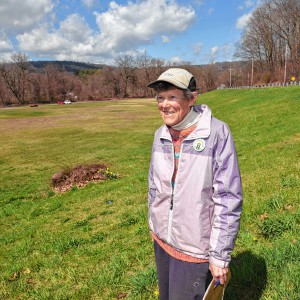Speaking of Nature: Parenthood and the midnight raiders — Raccoon breeding season
| Published: 05-07-2023 11:08 PM |
Three or four times last week I noticed an enormous raccoon on my deck in the moments just before dawn. This was clearly a raccoon that was scrounging for any scraps left over from the meal that I had set out for the birds the evening before and I found myself filled with a measure of sympathy. Hunger is a powerful motivation for any animal, but at this time of year it is particularly motivating for adult female raccoons. The reason? Well, it’s just about at this time of year that female raccoons give birth to the year’s kits.
So, try to put yourself into the shoes of a new mother. You have found a safe place to give birth to your babies and you are able to keep them warm and relatively dry. Hollow trees are great spots for this, but safe housing is only part of the challenge. Once the babies are born you will need to provide a constant supply of milk, which means that you yourself will need to find reliable sources of food and water. But where to look?
Imagine that you leave your newborn babies alone in the relative safety of your den and then you have to look for food. Where do you go? Scrounging for bits and pieces is time consuming and you don’t always know what you are going to find, if anything. This might be a way to find enough food for just yourself, but you’re now supporting offspring that cannot be left alone for too long, especially when they are very young. So where do you go?
Well, you’ve spent your entire life exploring the landscape in which you live and there are certain places that stand out in your mind. There’s that pond that sometimes has frogs. There’s that road that sometimes has dead things in it that are edible. And then there are those houses that sometimes have the most delicious treats imaginable. Those birdfeeders filled with delicious seeds, those other bird feeders filled with delicious suet cakes, and those birdbaths filled with clean water. What could be better. Oooo! Don’t forget that sometimes there are bowls of cat food and dog food. Or how about those giant containers filled with all sorts of food?
So, at this time of the year I am particularly sympathetic to the plight of a hungry raccoon because I can’t help but remember the nest of raccoons that I found almost two years ago in my own back woods. The nest site was a large cavity in an ancient sugar maple that had clearly been dealt some serious injuries in the past. The cavity was so extensive that it spanned from one side of the trunk to the other, but the main entrance was on the north side of the tree. I only realized that the cavity was occupied when I saw the tip of a striped tail sticking out of the crevice on the south side of the tree.
The mother raccoon clearly had her hands full with what turned out to be four healthy kits. As I approached the tree she popped her head up to determine the level of threat and I am absolutely certain that she was concerned. Her secret place was no longer a secret. Would the human standing over there and pointing something at me that made quiet clicking sounds turn out to be a threat?
But as she tried to determine the possible danger that her little family was in, her little children remained oblivious to the situation and were clearly interested in playing. One of her babies decided to chomp down on the fur on the side of her face and play a little game of tug-o-war. Another one of her babies was engaged in a series of barrel rolls right under her chin and would occasionally deliver a karate kick to her throat as it lay on its back and wrestled with other siblings that I couldn’t really see. Ah, the indignities of parenthood!
I discovered the nest of raccoons near the end of June, but at this time of year any baby raccoons are going to be very small and far less active. This is a good thing for the new mothers out there because they won’t require as much food to keep themselves and their babies alive. But as time passes as the little raccoons become larger and more active, their appetites will grow and the demands on the adult females will increase. This means that delicious food left out by humans will become more and more irresistible.
Article continues after...
Yesterday's Most Read Articles
 Greenfield man arrested in New York on murder charge
Greenfield man arrested in New York on murder charge
 Man allegedly steals $100K worth of items from Northampton, South Deerfield businesses
Man allegedly steals $100K worth of items from Northampton, South Deerfield businesses
 Greenfield Police Logs: April 9 to April 17, 2024
Greenfield Police Logs: April 9 to April 17, 2024
 Former Leyden police chief Daniel Galvis charged with larceny
Former Leyden police chief Daniel Galvis charged with larceny
 Shea Theater mural artist chosen out of 354 applicants
Shea Theater mural artist chosen out of 354 applicants
 Millers Meadow idea would ‘completely transform’ Colrain Street lot in Greenfield
Millers Meadow idea would ‘completely transform’ Colrain Street lot in Greenfield
The big problem is that intentionally providing food for wild animals is fraught with all sorts of negative issues for all parties concerned. Humans live near roads and roads are notoriously dangerous for raccoons. Food left out for raccoons may also attract the attention of other hungry animals. Coyotes might kill and eat a raccoon if they cross paths. Opossums might deliver some pretty savage bites in a physical altercation. Dogs and cats might injure, or be injured by raccoons. Then, there is the nuclear option that might be deployed by an aggravated skunk, rendering the entire area uninhabitable for days.
Don’t feed the raccoons intentionally, but don’t hold any malice toward them either. They are just hungry and in many cases they may be mothers with families of hungry children that need to be taken care of. And if you do notice that you have regular visitors in your yard, take the precaution of turning on the lights and looking outside before you head outside. This will give everyone a chance to leave the area gracefully, rather than in a panic. But if you leave no food out, then you will have no problems.
Bill Danielson has been a professional writer and nature photographer for 25 years. He has worked for the National Park Service, the U.S. Forest Service, the Nature Conservancy and the Massachusetts State Parks and he currently teaches high school biology and physics. For more in formation visit his website at www.speakingofnature.com, or head over to Speaking of Nature on Facebook.
]]>

 Speaking of Nature: Indulging in eye candy: Finally, after such a long wait, it’s beginning to look like spring is here
Speaking of Nature: Indulging in eye candy: Finally, after such a long wait, it’s beginning to look like spring is here Celebrating ‘Seasonings’: New book by veteran preacher and poet, Allen ‘Mick’ Comstock
Celebrating ‘Seasonings’: New book by veteran preacher and poet, Allen ‘Mick’ Comstock Faith Matters: How to still the muddy waters of overthinking: Clarity, peace and God can be found in the quiet spaces
Faith Matters: How to still the muddy waters of overthinking: Clarity, peace and God can be found in the quiet spaces A time for every purpose under heaven: Free sing-a-long Pete Seeger Fest returns to Ashfield, April 6
A time for every purpose under heaven: Free sing-a-long Pete Seeger Fest returns to Ashfield, April 6
